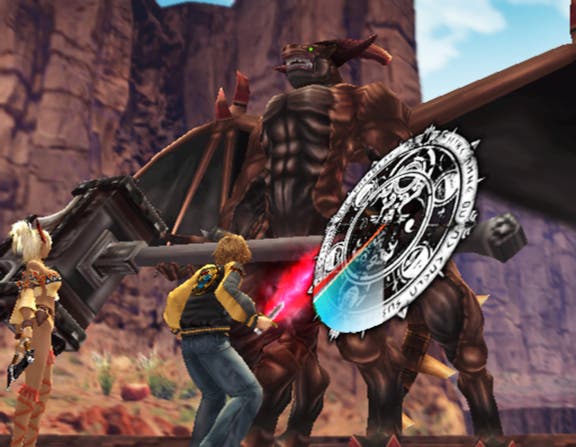Shadow Hearts: From The New World
Brave New Weird.
Here's the deal. There's this guy - fairly normal chap, goes by the name of Johnny Garland, deeply androgynous in that way which Japanese designers seem to think is hot (as distinct from merely confusing). He's on an adventure of some description; the adventure doesn't matter right now. What does matter is the people he's with.
His sidekick, the female lead of this piece, is a Native American who keeps transforming into powerful native spirits - but she's the least of his worries. The motley band he has assembled also includes Frank, an American ninja who speaks in an appalling mock-Japanese accent and studied in a dojo in the Amazon. There's a chap called Natan who specialises in the long-lost art of "gun-fu", a combination of firearms and chop socky which we suspect has been long lost for a good reason.
Then there's Hilda, a schizophrenic vampire and insatiable gourmand whose personality and combat abilities shift radically according to how many calories she has consumed that day. And then there's Mao, a lazy talking cat who turns out to be Frank's sensei - and has a hand (a paw?) in movie production, not to mention some involvement with the mob...
If any of that made you even remotely think about cracking a grin, then you should probably play Shadow Hearts: From The New World. We think you'll like it.
Hamming up the Depression

We should also add that if you enjoyed the last entry in the series, Shadow Hearts: Covenant, then there's no question but that you'll like From The New World. Developers XSEED have, at the heart of it, managed to capture most of the things that were really, really good about the last Shadow Hearts outing - from the utterly oddball sense of humour to the unique ability progression system, which focuses on quests and sub-games to unlock abilities, rather than on simple levelling up.
The storyline, unsurprisingly, is every bit as peculiar as previous games in the series have managed. The aforementioned fresh-faced young Johnny is running a detective agency in New York in the 1920s, but a seemingly normal case suddenly puts him in contact with a shadowy netherworld when the man he's following is murdered by a demon right in front of his astonished, androgynous face. From there on, the plot rapidly gathers pace - and the menagerie of characters swells - to encompass everything from the utterly familiar (young orphaned Johnny has a Dark And Mysterious Past to uncover - well, blow me down!) to the completely bloody weird. Like, say, staging a rescue operation to get Al Capone out of Alcatraz. No, really.
The plot hums along at a fair old pace, and as ever, Shadow Hearts provides plenty of distractions to stop you getting bored. There are a solid ten hours of side-quests in the game, alongside about thirty hours of main storyline - with the various quests rewarding your characters with new abilities or powerups which make them well worth exploring.
However, we have to confess that it took a lot longer to warm to Johnny and his crowd - and, indeed, to the American Depression setting through which they move - than it did to fall head over heels for Yuri, Karin and the rest of the band in Shadow Hearts Covenant. In some ways, that might just be that we had previously followed Yuri through the original Shadow Hearts - but by and large, it just feels like Covenant was able to balance its humour with its drama a bit better. The cast of From A New World are so busy trying to be Kerrrraazy!!! that that their dramatic or emotive moments feel a little bit lost; and much as we appreciate the humour, there's nothing here with quite the depth of Yuri's personal quest in Covenant.
Lord of the Ring

The combat system in the game once again focuses on the chief innovation of the series, the Judgement Ring. If you have encountered a Shadow Hearts game before, then you'll know exactly how this works; for the uninitiated, it's a ring which appears whenever you fire off an attack in combat (or do anything else that requires an element of chance or skill to be taken into account), with a hand sweeping rapidly around the face. Your job is to hit a button when the hand is in specific highlighted segments of the ring. Missing entirely means that your attack (or other task) fails, while with some attacks it's possible to change the power by hitting the ring in certain places, or to pile on extra blows by hitting multiple segments.
It's a system which is very simple, but works surprisingly well. It gives a solid sense of involvement and interaction in the battle system, and it's rarely too difficult even for those of you who play RPGs largely because your reaction times aren't up to faster games. You know who you are. If all else fails, one of the game's side attractions is a ghost outside Johnny's apartment who is looking for specific items, and will reward you with power-ups which increase the size of the hit segments on your rings, or otherwise decrease the difficulty level.
While each character has their own relatively unique fighting system, as a result of the various abilities they sport, the game does also boast a number of innovations which touch on the battle system as a whole. Chief among these is the "stock" gauge, which effectively allows both players and monsters to store up power as they take or deliver damage. A full stock gauge can be used to unleash multiple-hit attacks, or multi-character combos - with the downside being that monsters, especially bosses, can also be incredibly dangerous with a full stock gauge, so you'll need to be sure to use attacks that decrease their stock to avoid a party wipe-out.
Magic abilities, meanwhile, now come from items called "stellars", which you will pick up as you progress through the game. To use them, they have to be affixed to special grids, which basically mimic the constellations - so, for example, you might have a constellation like Cancer with stellars carrying different magics attached to all of the star positions, thus defining a character's magical abilities. Adding a layer of complexity is the ability to upgrade the magic "nodes" on those grids, which allows you to affix more powerful stellars or enhance the existing ones.

By and large, the battle system remains just as strong and compelling as it was in Covenant - which is just as well, really, because you'll be seeing a lot of it. The encounter rate in From The New World is very high in some places, which can feel somewhat frustrating - but at least the battle system is pretty consistently entertaining, and the load delays are extremely short.
New World Order
The Shadow Hearts series, originally a gothic departure from the normal trappings of the RPG genre, has settled into a well-defined niche of its own; aside from the judgement ring, it's the weird, eclectic cast of characters which really make this game, just as they were such an important part of Covenant. It's certainly not all things to all men, and many people will find the light hearted, camp approach to storytelling to be a real turn-off - but for fans of Covenant, this is a second serving of broadly the same thing. Given how enjoyable the last game was, that's a pretty high recommendation.
However, like many second servings, we can't help but feel that this has gone a little bit cold since we last enjoyed it. A newcomer to the series would be strongly advised to play Covenant in preference to this game; From The New World, although it delivers some innovation in its combat, is definitely a weaker game in story and characterisation terms. It's not exactly a harsh criticism - but it's not exactly the gushing commendation we give to our friends regarding Covenant, either. It would be unfair to call this game a stumble for the series; but equally, we find ourselves secretly hoping that XSEED can pick things up a bit for their next outing.

